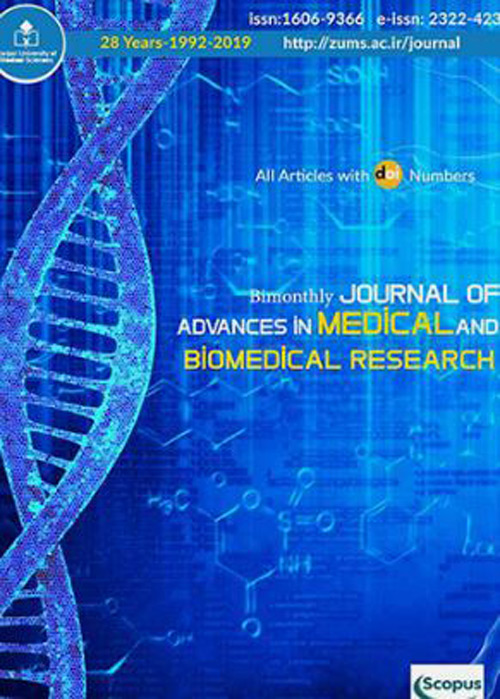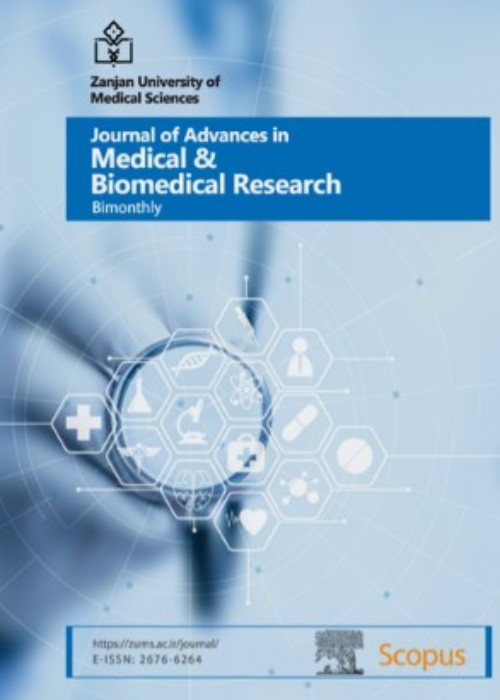فهرست مطالب

Journal of Advances in Medical and Biomedical Research
Volume:27 Issue: 122, May-June 2019
- تاریخ انتشار: 1398/02/11
- تعداد عناوین: 8
-
-
صفحات 23-28
-
Pages 1-8Background & Objective
The incidence of biofilm-related infections caused by Candida albicans has increased dramatically. C. albicans biofilm-related infections are more resistant to antifungal medications. This work was an attempt to examine inhibitory effects of fluconazole in combination with amphotericin B on fluconazole-resistant C. albicans biofilm.
Materials & MethodsFluconazole-resistant C. albicans was identified among colonized clinical isolates of C. albicans obtained from the patients at Shahid Beheshti Hospital, Yasooj, Iran, between September 2016 and January 2017. The MICs of fluconazole alone and in combination with amphotericin B were determined on fluconazole-resistant C. albicans by broth microdilution method based on the CLSI document M27-A3 and the synergistic effects were interpreted by the FIC index. To address the inhibitory effects of drug combinations, we investigated the anti-biofilm activities of fluconazole alone and in combination with amphotericin B against fluconazole-resistant C. albicans using crystal violet staining, light field microscopy and expression analysis of HWP1 using RT-PCR.
ResultsTen percent of the colonizing clinical isolates of C. albicans were found to be fluconazole-resistant. The fluconazole combined with amphotericin B exhibited synergistic and partial synergistic effects against fluconazole-resistant C. albicans isolates with FIC index ranging from 0.50 to 0.75. Our findings demonstrated that fluconazole combined with amphotericin B exerted a significant reduction and inhibition on biomass, biofilm formation and the expression levels of HWP1 (P<0.05).
ConclusionFluconazole combined with amphotericin B showed potent inhibitory activity against fluconazole-resistant C. albicans biofilm formation. Other measures are important to determine the effectiveness of the drug combinations against C. albicans biofilm.
Keywords: Amphotericin B, Antifungal agents, Biofilm, Candida albicans, Fluconazole -
Pages 9-15Background & Objective
Pain is a common symptom among people with MS. In the majority of MS patients, pain is chronic in nature, but it can change over time. The objective of this study was to determine if pain type can predict pain severity changes in individuals with MS over time.
Materials & MethodsThe research method was a longitudinal design that evaluated pain type and severity at baseline and after 3 years of follow up among people with MS. At the beginning of the study a random sample comprising of 188 individuals with MS were recruited. From those, 78 individuals experienced pain included the study. The McGill pain questionnaire and ID-Pain questionnaire were used to assess type of pain. Numeric Rating Scale was used to measure pain severity. McNemar, Cohen’s un-weighted Kappa Coefficient, Paired Student t-tests and Generalized Estimating Equations were used to analyze the data.
ResultsFindings indicated that all pain severity ratings raised on average, though this difference was statistically significant only for lowest pain (P=0.0006). Type of pain did not change in the major part of study sample (P=0.44). Results further indicated that over the follow-up period the lowest pain severity scores were significantly predicted by type of pain (P<0.05), while the pain ratings in worst pain severity was not predicted by the type of pain.
ConclusionResults of the current study help for better understanding of the pain type and severity changes over time among patients with MS.
Keywords: Multiple sclerosis, Neuropathic pain, Pain stability, Generalized estimating equation -
Pages 17-22Background & Objective
Perovskia abrotanoides Karel locally known as Brazambal, is widely used in medical practice to treat various disorders. Burn is a common source of injury and Brazambal ointment has been extensively used in burn wound healing in North of Iran. The purpose of this study was to examine the healing effect of Brazambal ointment in experimental model of burn. In addition, in-vitro healing characteristics and antibacterial activity of P. abrotanoides was investigated.
Materials & MethodsScald burn injury was produced by pouring 2.5cc of boiling water (95ºC) on the posterior surface of rat’s neck for 10 seconds. Twenty-eight adult male Sprague Dawley rats were divided into 4 groups (7 rats each) and followed for 7 days. Control group (no treatment); Silver sulfadiazine-treated group; Brazambal ointment-treated group; and vehicle-treated group received the complete ointment without Brazambal part. The effects of Brazambal aqueous extract on fibroblast cells and antibacterial activity against Escherichia coli, Staphylococcus aureus and Pseudomonas aeruginosa were evaluated.
ResultsTopical application of Brazambal ointment can accelerate wound healing process by initiating re-epithelialization and formation of granulation tissue. Proliferative activity of the aqueous extract on fibroblast cells was observed after 48 h in concentrations of 7.5% and 10% (P<0.0001). However, P. abrotanoides Karel extract had no significant antibacterial effect.
ConclusionThe presence of hair follicles, re-epithelialization and granulation tissue is suggestive of Brazambal ointment relative effectiveness on experimental scald burn in rats. However, further studies are warranted to reveal the healing mechanisms of P. abrotanoides.
Keywords: Perovskia abrotanoides, Brazambal, Traditional medicine, Burn -
Pages 23-28Background & Objective
Lifestyle is an important factor in determining family and community health. Therefore, the current study aimed to determine the status of mothers' lifestyle in Zanjan province, Iran.
Materials & MethodsThe study is part of a national cross-sectional project implemented by the National Institute for Medical Research Development (NIMAD) in Iran. This study used multi-stage cluster sampling and included 1039 mothers from Zanjan province in 2015-2016. The data gathering tools were the lifestyle questionnaire (LSQ) and a demographic questionnaire. Data were analyzed by SPSS 20.
ResultsThe results showed that the lifestyle status of 4.6% of the mothers was lower than the normal level, 89.3% at the normal level, and 6.1% was good. Mean and standard deviation of the total lifestyle of mothers was 2.01±0.31. Evaluating the mean of lifestyle components showed that the highest mean of lifestyle status in mothers in Zanjan province was related to drugs avoidance (M=2.65) and the lowest mean was related to sport and health components (M=1.44).
ConclusionThe lifestyle status of the studied samples was predominantly at normal level. However, their status in such components as exercise and health, environmental health, weight control, nutrition, and physical health was not very favorable, which makes it necessary to plan more precisely in this area. Results showed that mothers living in the city had a significantly better lifestyle than those living in rural areas. Findings also indicated that mothers with a higher level of education had a better lifestyle than those with a lower level.
Keywords: Lifestyle, Mothers, Nutrition, Physical health, Weight control, Zanjan province -
Pages 29-34Background & Objective
Chronic Kidney Disease (CKD) has been recognized as a serious public health threat. The early detection of kidney damage in CKD is a useful way to reduce the disease burden. This study aimed to determine the power of Neutrophil gelatinase-associated lipocalin (NGAL) and cystatin C (Cys-C) to predict the kidney damage in Iranian patients.
Materials & MethodsThis study was conducted at Shohadaye Tajrish Hospital on 72 renal patients. The estimated glomerular filtration rate (GFR) was assumed as the gold standard method. The NGAL and Cys-C were used as predictors and estimated GFR was used as a response variable. Three logistic regression models were fitted to investigate the impact of single and multiple markers for the prediction of GFR status.
ResultsThe regression models with NGAL and Cys-C as single predictors, and with both of them as multivariate predictors, were fitted to the data. The markers except for Cys-C were significantly related to the renal damage in all models (P<0.05). The obtained odds ratio for the model with NGAL, Cys-Cand both NGAL and Cys-C were 1.142, 1.004 and 1.125, respectively. The sensitivity and specificity of the models with NGAL, Cys-C and both of them were 96.00 and 100.00; 64.00 and 97.87; and 96.00 and 100, respectively.
ConclusionOur findings revealed that the NGAL biomarker as a single predictor could result in high predictor power for classifying the patients with and without kidney damage. Thus, the clinicians can use this marker for the early prediction of this renal problem.
Keywords: Kidney damage, NGAL, Cystatin C, AUC, Iranian population -
Pages 35-41Background & Objective
Prostate cancer is the most common cancer in men. The purpose of this study was to determine the effect of combined training (aerobic-resistance) on serum levels of insulin-like growth factor-I (IGF-I) and insulin-like growth factor-binding proteins 3 (IGFBP-3) in men with prostate cancer.
Materials & Methods20 eligible men with prostate cancer with an average age of 62.6±7.71 years, height of 172.15±5.02 cm, average weight of 75.6±11.6 kg, and the body mass index 25.54±3.47 were divided randomly into two groups (10 individuals each): the control and experimental groups. The experimental group experienced eight weeks of combined training (Aerobic resistance) with three sessions per week. During this period the control group did not participate in any exercise. At the beginning and the end of the period, 5 mL blood samples were taken to measure serum levels of IGF-I and IGFBP-3. The obtained data were then analyzed using ANCOVA with P-value≤ 0.05.
ResultsThe results showed that the eight weeks of combined training significantly reduced the level of IGF-I in the experimental group (P=0.001). Also, the combined training significantly increased the level of IGFBP-3 in the experimental group, which was significantly different from the control group (P=0.036).
ConclusionThe results of this study indicate that the combined training can affect some of the factors associated with prostate cancer and may be able to contribute to the improvement of patients' disease (along with the main treatment protocol)
Keywords: Combined training, Prostate cancer, IGF-I, IGFBP-3 -
Pages 43-49Background & Objective
Multiple Sclerosis (MS) is a common chronic inflammatory disease of the central nervous system. Postural control and motor function disorders are the most common MS related symptoms. Currently, exercise therapy seems to be the most effective non-pharmacological approach in controlling and improving these disorders. Thus, the present study intends to study the effect of combined training protocol on postural control and motor functions of individuals with MS.
Materials & MethodsAfter selecting 60 women with MS as the study sample, they were randomly assigned to two training intervention and control groups, each comprised of 30 subjects. The training intervention group performed the combined training protocol for eight weeks.
ResultsThe results of the covariance analysis showed that the combined training protocol had a significant effect on all postural control (postural sway indexes and Berg Balance Scale) and motor function (Timed 25 Feet Walk test and Timed Up and Go test) variables in individuals with MS (P≤0.05).
ConclusionThe results of this study indicated that the combined training protocol improved postural control and motor functions of individuals with MS. Therefore, these results may be recommended to all individuals who are making an effort to treat and improve individuals with MS.
Keywords: Multiple Sclerosis, Postural Control, Motor Function, Combined Training Protocol -
Pages 51-56Background & Objective
Social anxiety disorder, which involves excessive anxiety of social situation due to fear of negative evaluation, is a debilitating disorder that leads to social dysfunction. The purpose of this study is to investigate Efficacy of Cognitive-Behavioral Group Therapy (CBGT) versus Group Hypnotherapy (GHT) on Brain/Behavioral Systems of Social Phobia Patients.
Materials & MethodsThirty subjects were included in this study and divided into two groups receiving either CBGT or GHT. The questionnaires of brain/behavioral systems (GWPQ) and social phobia (SPIN) were administered in two phases (before and after intervention).
ResultsBoth therapy approaches caused significant changes in the level of social phobia and brain/behavioral systems activity. The alterations in brain-behavioral subsystems (BIS and FFFS) in the Extinction and Flight components were in favor of hypnotherapy (P<0.05).
ConclusionThe findings from the present research provide evidence that altering brain/behavioral systems associated with the social phobia hypnotherapy can be considered as a powerful approach treating social phobia.
Keywords: Social phobia, General anxiety disorder, Brain, behavioral systems, Reinforcement sensitivity theory, BIS, FFFS, Cognitive-behavioral therapy, Hypnotherapy, Hypnosis


